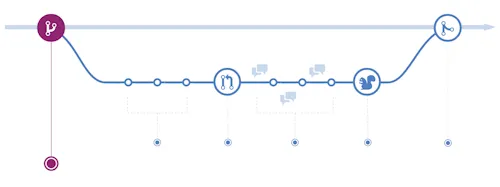GitHub Flow - A Streamlined Approach to Version Control
September 4, 2023

GitHub Flow is a simple, branch-based workflow that supports teams and projects where deployments are made regularly. This workflow was introduced by GitHub to accommodate the unique needs of its platform and users, emphasizing the importance of conversation and collaboration in software development.
In this article, we will walk you through the basisc of GitHub Flow, it’s history, its pros and cons, and the basics of how to work with it in your development workflow.
A Brief (Really Brief) History
GitHub Flow was developed by GitHub around 2011 as a streamlined workflow for project management on its platform. The goal was to create a workflow that encourages frequent code integrations and makes the deployment process more efficient. Over the years, it has gained popularity due to its simplicity and effectiveness in managing both small and large projects.
Pros and Cons of GitHub Flow
Pros
- Simplicity: GitHub Flow is easy to understand and implement, making it accessible for teams of all sizes.
- Continuous Deployment: It supports continuous deployment, allowing teams to deliver updates and improvements to users more frequently.
- Collaboration: The Pull Request mechanism fosters code review and collaboration.
Cons
- Requires Discipline: Teams need to be disciplined in making small, frequent commits and ensuring that the
mainbranch is always deployable. - Lack of Explicit Release Support: Unlike other workflows like GitFlow, GitHub Flow doesn’t have explicit support for versioned releases.
Setting Up GitHub Flow
Setting up GitHub Flow involves initializing a Git repository and creating branches for each feature or bug fix:
# Initialize a new Git repository
git init
# Create a new branch for your feature
git checkout -b feature_branch
Using GitHub Flow Like a Pro
Here’s a typical workflow in GitHub Flow:
# Update your local 'main' branch
git pull origin main
# Create a new branch for your feature
git checkout -b feature_branch
# Make some changes and commit them
git add .
git commit -m "Add new feature"
# Push your changes to the remote 'feature_branch'
git push origin feature_branch
# Open a Pull Request for your changes
# After review and approval, merge your changes into the 'main' branch
Comparison with Other Branching Strategies
GitFlow
GitFlow is a popular branching model that uses multiple long-lived branches to manage different stages of the development lifecycle.
Pros of GitFlow
- Explicit Release Support: GitFlow provides explicit support for versioned releases.
- Separation of Concerns: It separates the development, release, and maintenance stages.
Cons of GitFlow
- Complexity: GitFlow is more complex than GitHub Flow due to its multiple branches.
- Slow Integration: Changes are integrated less frequently than in GitHub Flow.
Trunk-Based Development (TBD)
TBD is a source-control branching model where developers work on a single branch called ‘trunk’, or ‘main’.
Pros of Trunk-Based Development
- Simplicity: TBD is straightforward and easy to understand.
- Fast Integration: Developers integrate their changes frequently.
Cons of Trunk-Based Development
- Requires Discipline: Like GitHub Flow, TBD requires discipline in making small, frequent commits.
- Potential Instability: Frequent integrations could lead to instability if not managed properly.
Final Thoughts
GitHub Flow offers a simple yet effective approach to version control that emphasizes collaboration, continuous integration, and deployment. While it requires discipline and doesn’t explicitly support versioned releases like GitFlow, its simplicity makes it an attractive option for many teams.
If you want to explore your options, please reach out to our team by via email at support@skratsch.com or by calling 1.313.284.5656
Tags: branchinggithubflowbeginner

Editor
Steve is a Software and Cloud Engineer, Content Creator, and Innovation Enthusiast. He is open to collaborating on projects that match his skills, which include .NET Framework/Core, C#, APIs, RESTful Services, SQL Databases, and Azure.